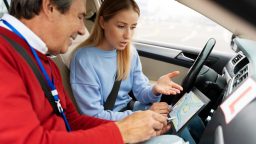In today’s rapidly evolving world, technology plays a crucial role in enhancing public safety. From improving emergency response times to preventing crime and ensuring safer communities, technological advancements are helping governments, law enforcement agencies, and individuals to protect citizens in innovative ways. Whether through sophisticated surveillance systems, real-time communication tools, or advanced predictive analytics, technology is transforming the way we approach safety. In this article, we will explore how technology is being used to enhance public safety and what the future holds for safer communities.
- Smart Surveillance Systems
One of the most noticeable advancements in public safety is the rise of smart surveillance systems. Traditional security cameras have evolved significantly, and today’s systems are equipped with advanced features like facial recognition, motion detection, and AI-powered analytics. These systems help law enforcement agencies monitor public spaces, identify suspects, and prevent crime before it happens.
For example, in some cities, AI algorithms can analyse video footage in real-time to detect suspicious activity or behaviour, such as loitering, fighting, or people entering restricted areas. This allows for immediate alerts to be sent to security personnel, who can then take action promptly. Additionally, smart surveillance cameras can provide clearer images and work in low-light conditions, increasing the reliability of public safety monitoring, even in challenging environments.
- Predictive Policing
Technology is also being used to predict and prevent crime through the use of data analytics and machine learning. Predictive policing tools analyse historical crime data, such as patterns of robberies, assaults, or drug-related activities, to forecast where crimes are likely to occur in the future. By identifying high-risk areas and times, law enforcement can deploy resources more effectively, focusing their efforts on places where crimes are more likely to happen.
These predictive tools help police departments allocate resources efficiently, reduce response times, and increase their chances of preventing crimes from taking place. However, it is essential for these tools to be used responsibly and ethically to avoid biases and ensure that the data used is accurate and fair.
- Real-Time Communication and Alert Systems
In emergencies, timely communication can be the difference between life and death. Real-time communication technologies are enhancing public safety by enabling faster responses to disasters, accidents, or criminal activities. Mass notification systems and emergency alert platforms allow governments and emergency services to send out warnings and updates in real-time, keeping the public informed and safe.
For example, systems like reverse 911 or mobile alert applications can notify citizens about severe weather conditions, active shooter situations, or natural disasters in their area. These tools can be vital for ensuring that individuals know when to evacuate, take shelter, or follow safety protocols. Similarly, two-way communication systems enable citizens to communicate directly with emergency responders, providing real-time updates on the situation.
- Drones for Search and Rescue Operations
Drones are increasingly being used in search and rescue operations to enhance public safety during natural disasters, missing person searches, or accidents in hard-to-reach areas. Drones equipped with high-definition cameras, thermal imaging, and sensors can quickly survey large areas, identify hotspots, and locate individuals in need of assistance.
In disaster response, drones provide an aerial view of affected areas, helping responders assess the situation and make informed decisions. In situations like wildfires, earthquakes, or floods, drones can be deployed to monitor the extent of the damage, identify survivors, and even deliver supplies to remote locations. The use of drones dramatically reduces the time it takes to conduct search and rescue missions, saving valuable lives in the process.
- Body-Worn Cameras for Law Enforcement
To ensure transparency and accountability, body-worn cameras (BWCs) have become an essential tool for law enforcement officers. These cameras, worn by police officers during their patrols, record interactions with the public, ensuring that all encounters are documented. BWCs can help reduce misconduct, increase accountability, and protect both the public and officers.
Body-worn cameras also provide valuable evidence in investigations, helping law enforcement agencies build stronger cases. The use of video footage can help to resolve disputes and clarify situations, ensuring that justice is served fairly. As the technology continues to improve, BWCs will become even more integrated into law enforcement protocols, enhancing public safety through increased transparency.
- Emergency Response Robots
The use of robots in emergency response is another innovative way that technology is enhancing public safety. Robots designed for hazardous environments, such as bomb disposal units or search and rescue missions, can operate in dangerous situations where human intervention would be risky. These robots can be equipped with sensors, cameras, and tools to safely perform tasks like clearing debris, detecting hazardous materials, or defusing bombs.
In urban environments, robotic first responders are being tested to assist emergency teams in situations such as fires, chemical spills, or medical emergencies. For example, robots with medical capabilities could be sent to the scene of an accident to provide basic first aid until human responders arrive. The use of robots in these scenarios can help protect human lives, reduce response times, and increase the overall efficiency of emergency operations.
- Smart Cities and IoT for Public Safety
The development of smart cities is another way that technology is enhancing public safety. Smart cities use Internet of Things (IoT) devices, sensors, and data analytics to improve infrastructure, reduce traffic accidents, and ensure that urban areas are safe and efficient. For example, smart traffic lights can adjust based on real-time traffic conditions, reducing congestion and preventing accidents. Smart streetlights equipped with motion sensors can detect pedestrians or vehicles and adjust lighting levels to enhance visibility and security.
In smart cities, connected cameras, sensors, and other IoT devices work together to monitor everything from air quality to traffic flow. This data can be analysed to identify safety risks, optimise resource allocation, and respond quickly to emergencies. By using data from IoT sensors, cities can be made safer, more efficient, and more responsive to citizens’ needs.
- Cybersecurity for Public Safety
As our society becomes more connected, cybersecurity has become a critical aspect of public safety. With increasing reliance on digital systems for everything from transportation to healthcare, protecting these systems from cyberattacks is essential to maintaining public safety. Cybersecurity technologies are being developed to safeguard critical infrastructure, such as power grids, water systems, and transportation networks, from cyber threats that could cause widespread disruption.
Governments and law enforcement agencies are also investing in advanced cybercrime detection tools to combat online threats like fraud, identity theft, and cyberbullying. By improving cybersecurity, technology helps protect both the physical and digital aspects of public safety, ensuring that citizens can live and work without the fear of cyber-related harm.
Conclusion
Technology is playing a vital role in enhancing public safety by providing innovative solutions that improve communication, surveillance, emergency response, and crime prevention. From AI-powered surveillance to drones and robotic first responders, the tools available to protect citizens are more advanced than ever. As technology continues to evolve, we can expect even more breakthroughs that will enhance the safety and security of individuals and communities. While challenges like privacy concerns and ethical considerations remain, the future of public safety will undoubtedly be shaped by technology, making the world a safer place for everyone.





